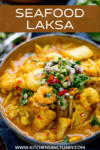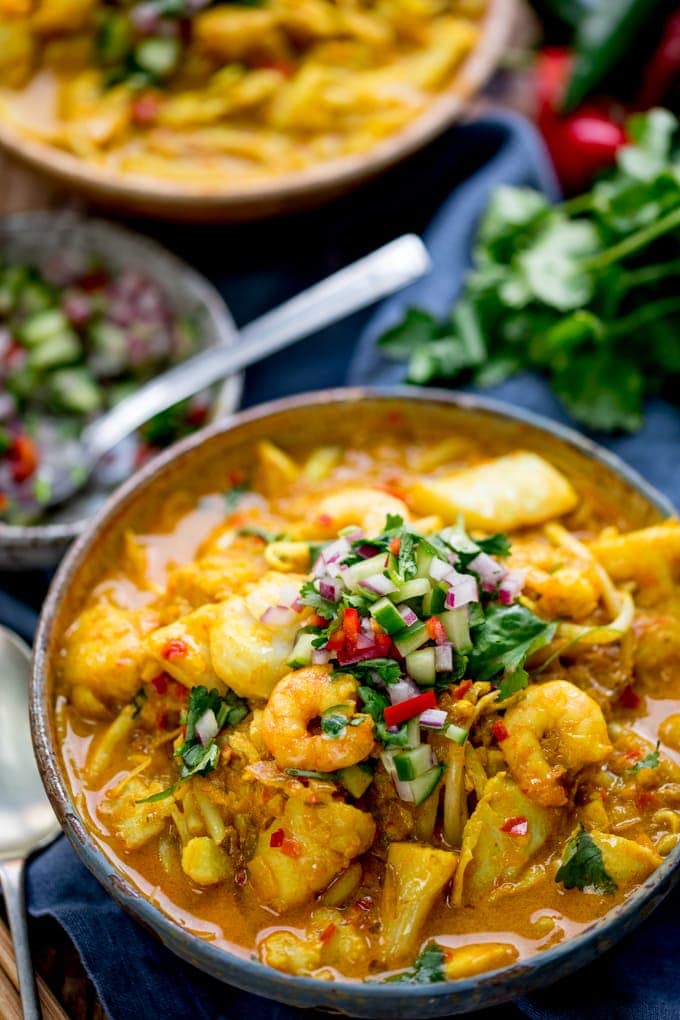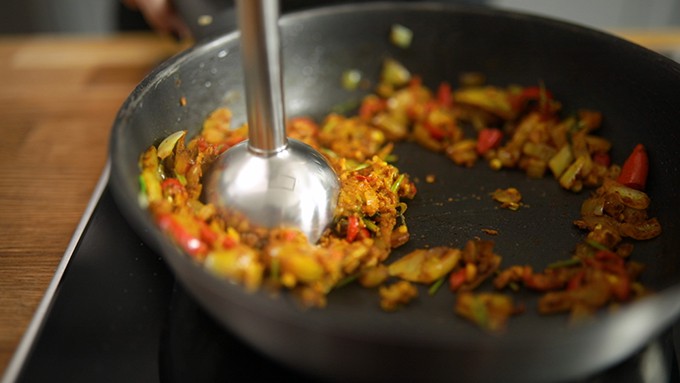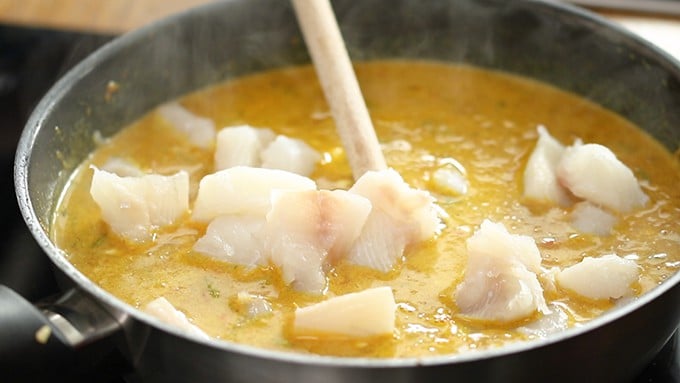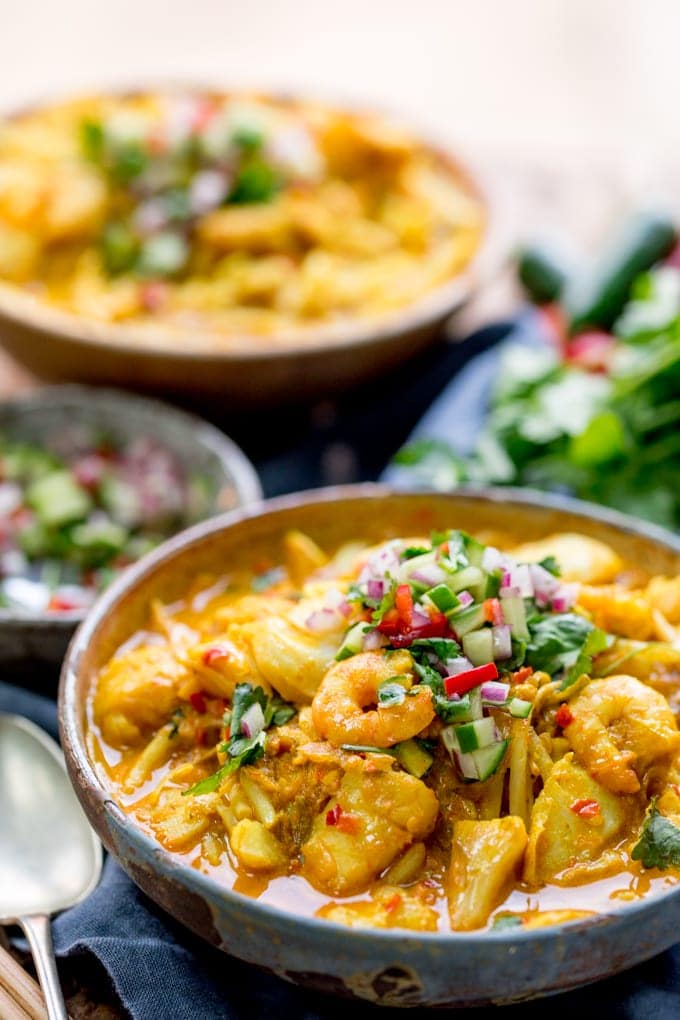A slurpy, splash-orange-coloured-sauce-down-your-white-top-in-enthusiastic-eagerness kind of soup, that makes you look at your husband’s bowl to see if he has any left that you could steal. That’s how good this soup is. It’s also on the table in less than half an hour. I first had laksa soup in a Thai restaurant, and I adored all the flavours and textures. I may have mentioned before that Thai is my favourite kind of food, and seafood laksa is such a great way to get a fabulous meal on the table quickly, using only one pan. The paste ingredients are cooked in a pan, then whizzed up with a stick blender: From my research, it seems that most laksa curry/soup recipes, whether from Malaysia, Singapore, Thailand or Indonesia, have the same basis of noodles, with seafood or chicken in a spicy coconut sauce. There’s also a variation called Asam Laksa, that doesn’t use coconut milk, but it uses fish paste and tamarind for a more sour, rather than creamy taste. Believed to have originated as a combination of Chinese noodle soup (brought over by early Chinese migrants settling in Malacca, Malaysia) and local spices and coconut milk, it falls firmly under the label of Peranakan cuisine. My version came about when I was pondering what to do with leftover haddock (I’d defrosted too much after making fish burgers and matchstick fries the previous night) and some prawns that I’d forgotten to put back in the freezer. The fish is poached in the sauce under perfectly tender: It was going to be some kind of fish stew, but then the Thai craving struck and I was unable to resist. I’ve made my own laksa paste for this recipe. Most store-bought versions are a good alternative, but it’s super quick to make your own paste, without fussing about with a pestle and mortar or a food processor. I like to cook my paste ingredients before blending them into a paste using a hand blender - right in the pan. You do have to be careful it doesn’t splash, so you can leave the sauce ingredients to cool a little before blending. I find that cooking the paste ingredients first gives the whole dish a deeper level of flavour. Beansprouts are added at the end to retain their crunch:
Recipe Tips:
I don’t like seafood, how do I make Chicken Laksa instead?
Yes, you can simply replace the haddock and prawns with cooked shredded chicken. Alternatively, you can add pieces of raw chicken in with the blended paste and cook until the chicken is sealed. Add the coconut milk and stock and simmer until the chicken is cooked through, then continue on with the rest of the recipe steps.
Can I freeze Laksa?
The noodles, seafood and beansprouts won’t freeze very well. If you want to get ahead, I’d suggest making the paste, and freezing it in portions. Then you can defrost and continue with the recipe from step 4 (make the garnish on the day of serving too).
Can I make low fat Laksa?
You could use low fat coconut milk, although being lower fat, it has more of a tendency to split. To counter this, I’d suggest leaving out the coconut milk until the end of cooking, then add the low-fat coconut milk to the laksa and heat through until hot. Don’t let it boil or it will split.
If you’ve tried my seafood laksa recipe then please rate the recipe and let me know how you got on in the comments below, I love hearing your thoughts and add-ons to my recipes! You can also follow me on INSTAGRAM, FACEBOOK, PINTEREST, and TWITTER to see what I’m up to in the kitchen, what recipes i’m loving, and of course YOUTUBE to see our latest recipe videos!
Scottish Beef Stew Bigos African Chicken and Peanut Stew Brazilian Fish Stew Irish Bunny Chow Beef Bourguignon Goulash
Below is the video for this recipe - as part of our 20 minute Tuesdays series: on YouTube. Please Subscribe to our channel.
The Seafood Laksa Recipe:
Some of the links in this post may be affiliate links – which means if you buy the product I get a small commission (at no extra cost to you). If you do buy, then thank you! That’s what helps us to keep Kitchen Sanctuary running. The nutritional information provided is approximate and can vary depending on several factors. For more information please see our Terms & Conditions. This recipe was first published in 2014 (check out the old picture below!). Newly updated with photos, tips and video in March 2018.
